
During my first trip to Kyoto, I got caught up visiting only the “top 5” tourist spots. Big mistake!
After talking to locals and fellow travelers, I discovered these 11 incredible places I wish I’d known about sooner.
From the peaceful Miyama Village to the magical evening walks through Pontocho Alley, these hidden treasures offer a deeper look into Kyoto’s heart.
Here’s what I missed – so you don’t have to. 😊
1. Miyama Thatched-roof Village

a. What Makes It Special
- Home to nearly 40 traditional thatched-roof farmhouses – the most you’ll find in one place in Japan
- Real families still live in these historic houses, keeping old traditions alive
- Recognized in 2021 by the UN World Tourism Organization as one of the world’s “Best Tourism Villages” for its thoughtful approach to tourism
- One of Japan’s rare places where you can experience genuine rural life
- Perfect spot to see how Japanese countryside culture continues today
b. What to See and Do

- Stroll through the village and admire the unique architecture of the thatched-roof houses
- Visit the Miyama Folk Museum to learn about the village’s history and traditional lifestyle
- Explore the Little Indigo Museum to see rare indigo-dyed textiles and learn about this traditional craft
- Check out the Chii Hachiman Shrine and Inari Shrine for their ornate woodwork and ancient trees
- Take a hike on the walking paths around the village for panoramic views
c. Where to Eat and Relax
- Oshokuji-dokoro Kitamura: Famous for freshly-made homemade soba noodles. Try their Tenmori Soba with kakiage and chicken tempura.
- Sakaya Pizza Café: Enjoy pizzas like genovese (basil pesto sauce) and quattro fromaggi (four-cheese) in a cozy cottage setting.
- Café Milan: Serves coffee, tea, pudding, and ice cream with a view overlooking the village.
- Café-gallery Saika: Offers homemade sweets like soft cream and Miyama fruits in a heritage farmhouse.
- Try local specialties like sweetfish from the Yura River or venison dishes at restaurants in the village.
d. How to Get There

- Take the JR Sanin Line (heading to Sonobe) from Kyoto Station to Sonobe Station.
- Transfer to the JR Sanin Line (heading to Kinosaki Onsen/Goma/Fukuchiyama) and continue to Hiyoshi Station. The journey takes around 45 minutes and costs 770 yen.
- Exit Hiyoshi Station and transfer to the Nantan City Bus.
- Alight at Kita, which takes an additional 45 minutes and costs 600 yen.
- From the bus stop, it’s a short walk to the village.
Read More: 10 Most Charming Small Towns in Japan
2. Pontocho Alley

a. What Makes It Special
- It’s one of Kyoto’s most well-preserved traditional entertainment districts, dating back to 1670
- The narrow alley runs parallel to the Kamo River, creating a unique and atmospheric setting
- Narrow alley packed with traditional restaurants and tea houses
- One of Kyoto’s famous geisha districts
- Charming ambiance with lanterns and cobblestone paths
b. What to See and Do

- Stroll through the narrow alley and admire the traditional wooden buildings
- Visit the Pontocho Kaburenjo Theater, especially during the Kamogawa Odori dances in May
- Explore the tiny side lanes branching off from the main alley
- Take photos of the atmospheric scenery, especially at night when the lanterns are lit
- Keep an eye out for geishas and maikos, but remember to be respectful and not impede their movement
c. Where to Eat

- Kappa Sushi: Hidden gem offering exceptional sushi in a charming atmosphere, with a friendly chef preparing sushi right before your eyes.
- Kichi Kichi Omurice: Famous for its theatrical omurice preparation, featuring a runny omelet dramatically sliced open over ketchup-flavored fried rice.
- Monsen – Kiyamachi: Specialty ramen shop known for its rich chicken broth ramen
- Kyoto Yakiniku Hiro Pontocho: Renowned yakiniku restaurant serving premium wagyu beef, run by a famous Kyoto beef shop.
- Kushiemon: Second-floor restaurant with river views, known for kushikatsu (deep-fried skewers) and seasonal side dishes.
- Ukiya Pontocho: Renowned soba noodle shop serving freshly handmade noodles daily, famous for their unique Uki Soba with whipped raw egg and natto.
- Pontocho Robin: In a 150-year-old townhouse, enjoy Japanese dishes with seasonal ingredients like rice pot, fresh seafood, salt-grilled wagyu, and tofu hot pot.
d. How to Get There
- Option 1: Take the Hankyu-Kyoto Line to Kyoto-Kawaramachi Station. From there, exit at 1A and walk about 5 minutes to Pontocho Alley.
- Option 2: Take Bus No. 205 from Kyoto Station (Stand B3) to Shijo Kawaramachi Bus Stop. The bus costs 230 yen, takes about 20 minutes, and it’s a 5-minute walk to Pontocho Alley from the stop.
Read More: Top 17 Things to Do in Kyoto
3. Ine Fishing Village

a. What Makes It Special
- Often called the “Venice of Japan” because of its unique boat houses (funaya) built right over the water
- Features 230 boat houses stretching 5 kilometers along the coast
- Protected by Japan as an Important Preservation District for its historic buildings
- Shows you how Japanese fishing villages have lived for hundreds of years
- Sits beautifully between the Sea of Japan and green mountains
- Still a working fishing village where locals continue their traditional way of life
b. What to See and Do

- Take a boat tour around the bay to get up-close views of the funaya and feed the seagulls
- The standard boat tour (sea taxi) lasts about 30 minutes and costs 1,000 yen for adults
- Children aged 12 and under can join the boat tour for free
- Visit Funayanosato Park for a panoramic view of the entire village
- Explore the narrow streets on foot to observe local life and traditional architecture
- Enjoy the serene coastal setting and picturesque views
- Rent a bicycle to explore the surrounding area
c. Where to Eat

- Wadatsumi Sushi Restaurant: Enjoy fresh sushi and seafood dishes while overlooking Ine Bay. Try their “Wadatsumi Sushi Gozen” or “Funaya Gozen” set meals.
- Ine Restaurant Funaya: Located at Funaya no Sato Roadside Station, offering fresh fish dishes like sashimi, seafood bowls, and arani (simmered fish).
- Funaya Shokudo: On the 2nd floor of Ine Town Tourism Association, serving local specialties like yellowtail shabu-shabu and seafood rice bowls.
d. How to Get There

Option 1:
- Take the JR Hashidate Limited Express from Kyoto Station to Amanohashidate Station (around 2 hours 10 minutes).
- After arriving at Amanohashidate Station, board the Tankai Bus to Ine (bus ride takes about 60 minutes).
- From the bus stop, it’s a short walk to the village.
- Total cost: 5,600 yen.
Option 2:
- Take the JR Hashidate Limited Express from Kyoto Station to Fukuchiyama Station.
- Transfer to the Tango Relay 3 Limited Express Amino to Miyazu Station (total travel time around 1 hour 50 minutes).
- After arriving at Miyazu Station, board the Tankai Bus to Ine (bus ride takes about 60 minutes and costs 400 yen).
- From the bus stop, it’s a short walk to the village.
- Total cost: 5,100 yen.
Read More: Top 17 Things to Do in Osaka
4. Amanohashidate
When you visit Amanohashidate in Kyoto, you’ll see one of Japan’s most beautiful spots. It’s a long sandbar filled with pine trees.
You can enjoy the famous upside-down view from two places.
Kasamatsu Park is on the north side, offering quiet and relaxing scenery. Viewland, on the south side, gives you beautiful views and fun activities that families will enjoy.
i. Amanohashidate Kasamatsu Park
a. What Makes It Special
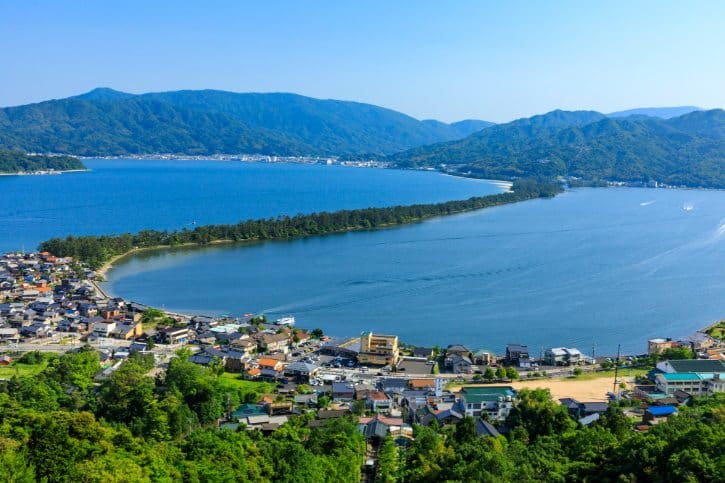
- Offers one of Japan’s most famous panoramic views overlooking Amanohashidate, one of the country’s “Three Most Scenic Spots”
- Birthplace of the unique “matanozoki” tradition, where viewing upside-down makes the sandbar seem to float in the sky
- Rich cultural heritage linked to local legends describing Amanohashidate as a “bridge to heaven”
- Beautiful seasonal landscapes, including cherry blossoms in spring, lush greenery in summer, vibrant autumn colors, and snowy scenery in winter
b. Enjoy a Scenic Cable Car or Chairlift Ride
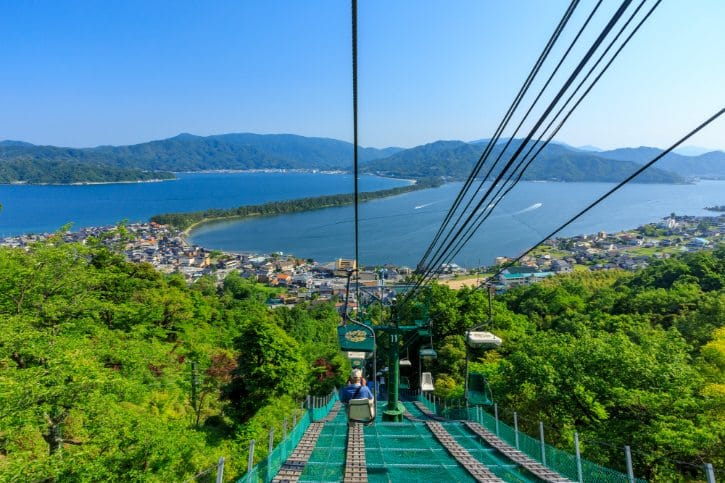
- Chairlift: Open-air seating, perfect for photos and enjoying fresh air. The ride lasts around 6 minutes. For the best views of Amanohashidate, it’s best to use the cable car going up and the chairlift coming down.
- Cable Car: Enclosed cabins, ideal for rainy days and families. The ride takes about 4 minutes.
c. Explore the Sky Deck and Viewing Platforms
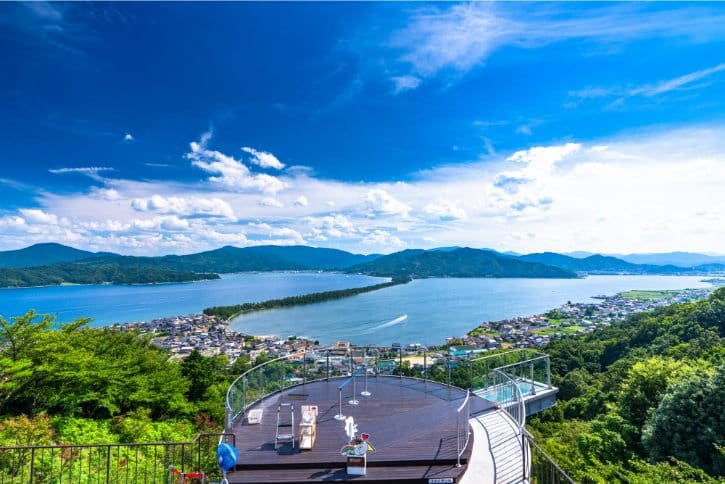
- Sky Deck: Round wooden deck with glass floor, excellent for panoramic views and taking pictures.
- Other Platforms: Several wooden decks, each offering a different view of Amanohashidate.
- Best Time: Visit from late morning to mid-afternoon. The views are especially beautiful during spring (cherry blossoms) and autumn (colorful leaves).
d. Experience the Famous “Matanozoki” Upside-Down View
- What It Is: A traditional way of viewing the landscape upside-down. Stand, bend forward, and look through your legs.
- Why Do It: Viewing Amanohashidate this way makes the sandbar appear as if it’s floating in the sky, known as the “flying dragon” view.
e. Have Fun Throwing Lucky Clay Discs (“Kawarake Nage”)
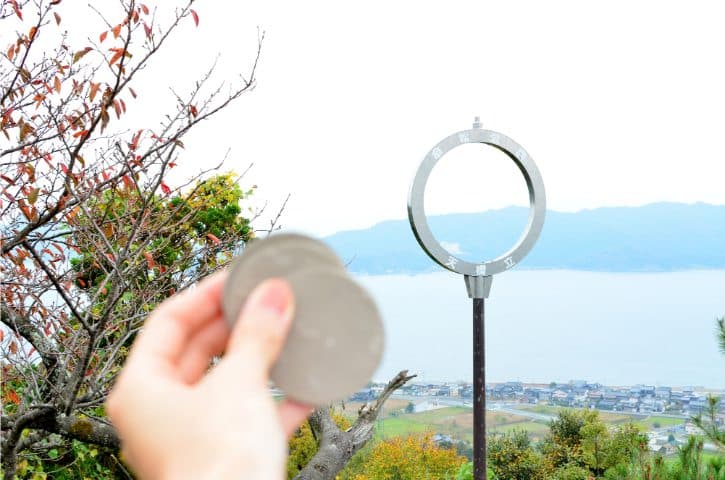
- Activity: Throw small clay discs downhill through a hoop-shaped target called “Chie-no-wa” for good luck.
- Cost: ¥200 for three discs.
- Tips: Throw gently, aiming just above the hoop. It’s fun whether you succeed or not.
f. How to Get to Amanohashidate Kasamatsu Park from Kyoto Station
- Train from Kyoto Station to Amanohashidate Station
-
- Take the JR Hashidate Limited Express directly to Amanohashidate Station.
- Journey Duration: Around 2 hours and 10 minutes.
- Fare: About ¥4,800 – ¥5,000 one-way, depending on the day you travel.
- From Amanohashidate Station to Kasamatsu Park Cable Car/Chairlift Station (Fuchu Station)
- Option A: By Bus
- Exit Amanohashidate Station.
- Board the Tankai Bus heading towards Ine or Hioki.
- Get off at the “Amanohashidate Cable-shita” stop (about 26 minutes).
- Walk around 3 minutes from the bus stop to the cable car/chairlift station.
- Option B: By Sightseeing Boat
- Walk from Amanohashidate Station to Amanohashidate Pier.
- Take the sightseeing boat to Ichinomiya Ferry Terminal.
- Boat Fare: ¥800.
- Boat Duration: About 12 minutes.
- Walk around 5 minutes from the ferry terminal to the cable car/chairlift station.
- Cable Car/Chairlift to Kasamatsu Park
- Choose either the cable car (4-minute ride) or chairlift (6-minute ride) to reach Kasamatsu Park.
- Round-trip Fare: ¥800 (adults), ¥400 (children).
- Recommendation: Take the cable car up the hill and chairlift back down for the best experience and views.
ii. Amanohashidate Viewland
a. What Makes It Special

- Offers one of Japan’s iconic views, known as the “Flying Dragon”, where the sandbar appears like a dragon soaring into the sky
- Part of Japan’s famous “Three Scenic Views”, alongside Miyajima and Matsushima
- Unique tradition of “matanozoki”, where you view the sandbar upside-down through your legs for a special perspective
- Family-friendly amusement park attractions like a Ferris wheel and go-karts combined with scenic beauty
b. Choose Between a Scenic Monorail or Chairlift Ride
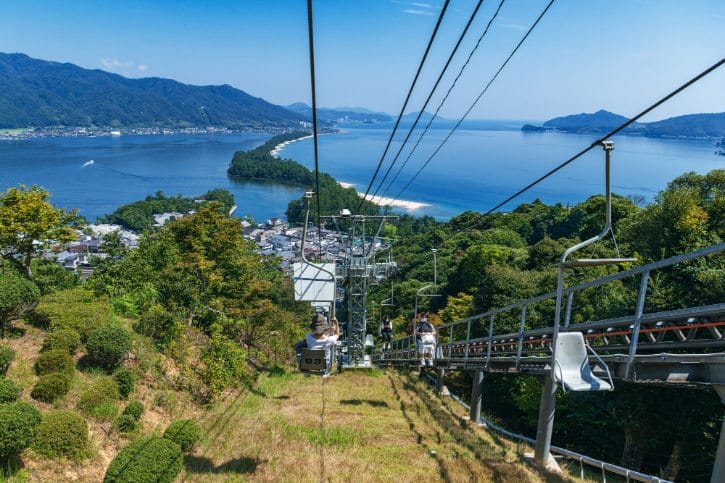
- Chairlift: Open-air seats with great scenery. The ride lasts around 6 minutes. It’s best to take the chairlift down from the top to enjoy the beautiful views of Amanohashidate as you descend.
- Monorail (Slope Car): Enclosed, comfortable, and takes about 7 minutes. It’s perfect if it’s raining or if you’re traveling with small children or strollers.
c. Enjoy Panoramic Views and the Unique “Matanozoki” Experience
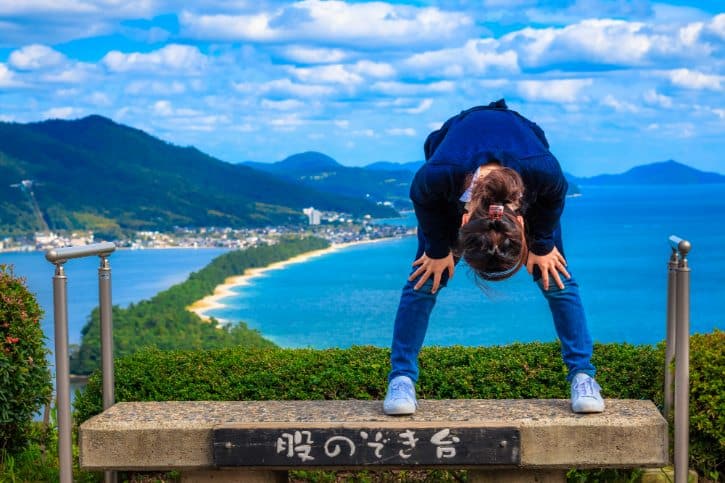
- Matanozoki (Upside-Down Viewing): Stand with your back to Amanohashidate, bend forward, and look through your legs. This fun method makes the sandbar appear like a flying dragon.
- Hiryukan-Kairo Deck: Walk along a 250-meter raised deck that provides 360-degree views of Amanohashidate. It’s great for relaxing walks and taking pictures.
d. Have Fun with Rides
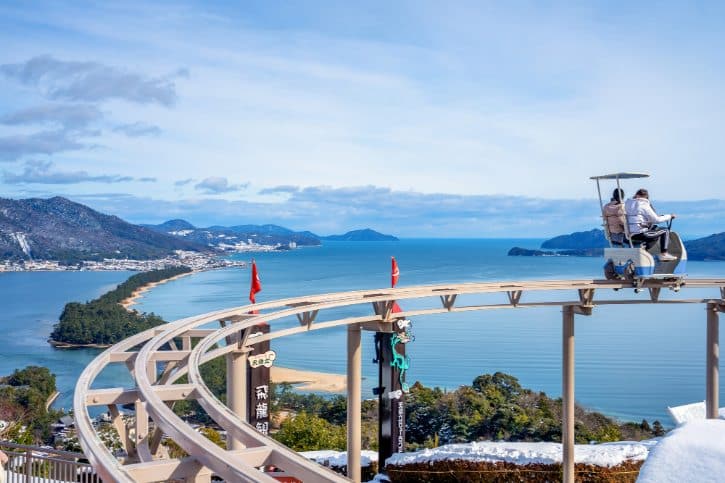
- Cycle Cars (Sky Cycling): Pedal-powered cars on raised tracks. You’ll have fun while enjoying views from above. Great for both adults and children.
- Ferris Wheel: A small, relaxing ride offering lovely views from up high.
e. Try Your Luck at Pottery Throwing (“Kawarake-nage”)
- Lucky Pottery Throwing: Buy small clay discs (“kawarake”) and throw them through a hoop (“Wisdom Ring”) for good luck. Simple and enjoyable, especially for kids.
f. How to Get to Amanohashidate Viewland from Kyoto Station
- Train from Kyoto Station to Amanohashidate Station
- Take the JR Hashidate Limited Express train directly to Amanohashidate Station.
- Journey Duration: Around 2 hours and 10 minutes.
- Fare: About ¥4,800 – ¥5,000 one-way, depending on your travel date.
- From Amanohashidate Station to Viewland Monorail/Chairlift Station
-
- Exit Amanohashidate Station.
- Walk about 5 minutes to reach the Amanohashidate Chairlift and Monorail Station.
- Monorail/Chairlift to Viewland
-
- Choose either the monorail (7-minute ride) or chairlift (6-minute ride) to reach Viewland.
- Round-trip Fare: ¥1,000 (adults), ¥500 (children).
- Recommendation: Take the monorail going up and the chairlift going down for the best views.
Read More: A Complete Day Trip Guide to Amanohashidate and Ine Funaya from Kyoto or Osaka
5. Kodaiji Temple
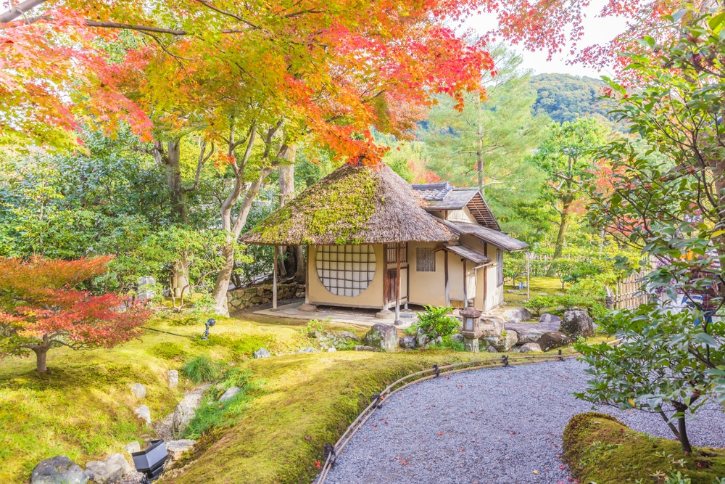
a. What Makes It Special
- Founded in 1606 by Nene, widow of Toyotomi Hideyoshi, one of Japan’s greatest historical figures
- It houses several Important Cultural Properties, including buildings and artworks
- Famous for its spectacular gardens and zen landscape
- Beautiful night illuminations during spring and autumn
b. What to See and Do

- Main Hall (Hojo): The central building, rebuilt in a modest style after a fire in 1912
- Rock Garden: A large field of raked gravel representing the ocean
- Tsukiyama-style Garden: Enjoy the pond, decorative rocks, and beautiful pine and maple trees
- Kaizando (Memorial Hall): Houses wooden images of Hideyoshi and his wife Nene
- Mausoleum: Richly decorated resting place of Hideyoshi and Nene
- Bamboo grove: Walk through a serene bamboo forest on your way back from the mausoleum
c. How to Get There
Take Kyoto City Bus No. 206 from Kyoto Station (Stand D2) to Kiyomizu-michi Bus Stop. This journey costs 230 yen and takes around 16 minutes. From Kiyomizu-michi, it’s a 7-minute walk to the temple.
Read More: 3 Days in Osaka Itinerary: How to Do It Under $370
6. Eikando Temple

a. What Makes It Special
- A 1,200-year-old Buddhist temple that’s been standing since 853 (also known as Zenrin-ji)
- Home to the unique “Looking-Back Amida Buddha” statue – different from other temple statues
- One of Kyoto’s best spots for autumn colors, especially in early to mid-November
- Lights up beautifully at night during fall with special illuminations
- Features peaceful Japanese gardens and a mirror-like pond (Hojo Pond)
- Perfect place for quiet moments and beautiful photos in any season
b. What to See and Do

- Explore the main buildings, including the Shakado (Hall of the historical Buddha), Miedo, and Amidado (Amida Hall)
- Climb up to the Tahoto Pagoda for panoramic views of the temple grounds and Kyoto city
- Stroll through the wooden corridors connecting various buildings, appreciating the temple’s unique layout
- Visit the Hojo Pond and its surrounding garden, especially beautiful during autumn
- Look for the famous Mikaeri Amida statue, known for its unusual sideways-facing pose
c. How to Get There
- Option 1: Take the Karasuma Subway Line from Kyoto Station to Karasuma Oike Station, then transfer to the Tozai Line to Keage Station. The trip takes about 30 minutes, costs 260 yen, and from Exit 1, it’s a 15-minute walk to the temple.
- Option 2: Take Kyoto City Bus No. 105 from Kyoto Station (Stand A1) to Miyanomaecho Bus Stop. The bus ride takes about 40 minutes, costs 230 yen, and Eikando Temple is a short walk from the stop.
Read More: Only 3 Best Places to Stay in Osaka
7. Ninenzaka and Sannenzaka

a. What Makes It Special
- Preserved historical atmosphere with traditional wooden buildings
- Cobblestone streets that transport you back in time
- Offers a glimpse into Kyoto’s rich cultural heritage
- Name means “two-year slope” – Ninenzaka
- Name means “three-year slope” – Sannenzaka
- Popular for its nostalgic charm and photo opportunities
b. What to See and Do

- Traditional tea houses and restaurants
- Souvenir shops selling local crafts and snacks
- Opportunity to see geishas and maikos (especially in the evening)
- Charming streetscape
- Shops selling woodcut prints and postcards
c. Where to Eat (Ninenzaka)

- Starbucks Kyoto Nineizaka Yasaka Chaya: Unique Starbucks featuring tatami seating, offering a blend of modern coffee and traditional Japanese atmosphere.
- Ishidatami: Known for excellent soft-serve ice cream, particularly their rich matcha flavor made with homemade sauce.
- Fujinami Kodai-ji Temple Store: Specializes in traditional Kyoto-style dango and mochi. Famous for handcrafted sweets using quality ingredients.
- Kasagiya: This traditional sweet shop offers a taste of Taisho-era Japan. Try their o-hagi (rice cakes) and zenzai (sweet bean soup).
d. Where to Eat (Sannenzaka)

- Fujinami: Preserves traditional Kyoto flavors. Recommended for iced matcha and dango, particularly their popular soy sauce-flavored dango.
- Kirakuan Okamoto Sanneizaka: Famous for “Maiko-yaki” treats shaped like geisha apprentices, available in red bean, cream, matcha, and ham & cheese flavors. Their croquettes are also popular.
- Okutan Kiyomizu: Known for handmade tofu. Specializes in soy milk and black honey shaved ice, praised for its rich homemade soy milk flavor.
- Ukiya Kiyomizu Kiseian: While famous for handmade soba, their oyakodon (especially the fried shrimp version) is exceptional, featuring crispy batter and tender shrimp.
- Umezono Kiyomizu: Established 1927, offers classic Japanese sweets including matcha, shiratama zenzai (red bean soup with mochi), warabi mochi, and seasonal specialties.
e. How to Get There
- Option 1: To reach Ninenzaka and Sannenzaka, take Kyoto City Bus No. 206 from Kyoto Station (Stand D2) and get off at Kiyomizu-michi Bus Stop. The bus ride costs 230 yen and takes around 25 minutes. From there, it’s a 10-minute walk.
- Option2: Take the Kyoto City Bus No. 106 from Kyoto Station (Stand D2) to the Kiyomizu-michi Bus Stop. The journey takes about 25 minutes and costs 230 yen.
Read More: 10 Must-Know Etiquette Rules Before Visiting Japan
8. Kinkaku-ji

a. What Makes It Special
- Golden pavilion covered in gold leaf, reflecting beautifully on a pond
- Surrounded by a traditional Japanese stroll garden
- One of Kyoto’s most iconic and popular attractions
b. What to See and Do
- Take in the stunning view of the pavilion reflected in the pond
- Notice the different architectural styles of each floor
- Look for the phoenix statue on top of the roof
- Try to spot the statues inside through the open doors (you can’t enter)
- Capture photos from various angles around the pond
c. Exploring the Gardens

- Find the coin-tossing statues for good luck
- Follow the designated path through the beautiful landscaped gardens
- Look for the Anmintaku Pond, said to never dry up
- Take a moment to appreciate the peaceful Zen atmosphere
d. How to Get There
Take Kyoto City Bus No. 205 from Kyoto Station (Stand B3) to Kinkakujimichi Bus Stop. The bus costs 230 yen and takes about 44 minutes. From the bus stop, it’s a 6-minute walk to the temple.
Read More: 10 Most Beautiful Places to Visit in Kyoto
9. Nishiki Market

a. What Makes It Special
- Over 400 years of history as Kyoto’s central food market
- Nicknamed “Kyoto’s Kitchen” for its wide variety of local ingredients and dishes
- A narrow, covered shopping street about 400 meters long
- Over 100 shops and stalls selling food, cookware, and local specialties
b. Must-Try Foods

- Tako tamago: Skewered octopus heads with quail eggs
- Soy milk doughnuts: Light and fluffy doughnuts made with soy milk
- Yuba: Tofu skin, a Kyoto delicacy
- Wagashi: Traditional Japanese sweets, perfect with tea
- Kushiage: Deep-fried skewers of various meats and vegetables
- Matcha soft serve ice cream: Creamy green tea flavored ice cream
- Tamagoyaki: Rolled omelet cooked in a special broth
c. Shopping Tips

- Bring cash, as many small stalls don’t accept cards
- Try samples before buying, many shops offer free tastings
- Look for unique Kyoto specialties like pickles and dried seafood
- Consider buying kitchen items like knives or chopsticks as souvenirs
- Remember that bargaining isn’t common in Japan, prices are usually fixed
d. How to Get There
- Option 1: To reach Nishiki Market, take the Karasuma Subway Line from Kyoto Station to Shijo Station (Exit 1). The subway ride costs 210 yen and takes about 5 minutes, then it’s a 10-minute walk to the market.
- Option 2: Take Kyoto City Bus No. 7 from Kyoto Station (Stand A2) to Shijo Kawaramachi Bus Stop. The bus costs 230 yen and takes around 15 minutes. From there, it’s a 5-minute walk to Nishiki Market.
10. Kiyomizudera Temple

a. What Makes It Special
- One of Kyoto’s most celebrated temples, founded in 780 AD
- The temple is a UNESCO World Heritage Site
- It’s nicknamed “Pure Water Temple” due to the Otowa Waterfall on its grounds
- It offers stunning views of Kyoto city and surrounding nature
b. Main Attractions

- Beautiful cherry blossoms in spring and colorful foliage in autumn
- Visit the Main Hall with its 13-meter-high stage and terrace offering panoramic Kyoto views
- Explore the Jishu Shrine, dedicated to the deity of love and matchmaking
- Visit the three-storied pagoda near the entrance, one of the tallest in Japan at 31 meters
c. Cultural Experiences

- Check out the Otowa Waterfall at the base of the Main Hall, where three streams offer blessings for health, success, and love
- Ring the temple bells and make a small offering at the Main Hall
- Try the love stones at Jishu Shrine – if you can walk between them with your eyes closed, it’s said to bring luck in love
d. How to Get There
- Option 1: Take Kyoto City Bus No. 206 from Kyoto Station (Stand D2) to Kiyomizu-michi Bus Stop. The bus costs 230 yen and takes about 25 minutes, followed by a 10-minute walk to the temple.
- Option 2: Take Kyoto City Bus No. 106 from Kyoto Station (Stand D2) to Kiyomizu-michi Bus Stop. This route also costs 230 yen and takes about 25 minutes.
11. Fushimi Inari Taisha

a. What Makes It Special
- It’s the head shrine of all Inari shrines in Japan, with over 1,300 years of history
- Dedicated to Inari, the Shinto deity of rice and prosperity
- Famous for thousands of vibrant orange torii gates
- Gates form a tunnel-like path up Mount Inari
b. What to See at the Main Shrine

- Start at the Romon Gate, donated in 1589 by Toyotomi Hideyoshi
- Visit the main hall (honden) to pay respects to the deity
- Look for the numerous fox statues – they’re considered messengers of Inari, the god of rice and prosperity
- Check out the “ema” (wooden plaques) with wishes written on them
- Don’t miss the fox-shaped ema, unique to this shrine
c. Unique Experiences

- Visit Fushimi Inari Shrine-Chaya for a traditional tea house experience. Try their famous amazake (sweet fermented rice drink), matcha ice cream, or refreshing shaved ice.
- Look for the “Heavy/Light Stone” along the trail.
- Try to spot the names of famous companies on the torii gates.
- Explore the smaller sub-shrines along the mountain trail.
- Dine at Inafuku, a local favorite known for its Inari sushi. Try their unique “Inarizushi Gozen” set meal, which includes various types of Inari sushi and seasonal side dishes.
d. How to Get There
- Option 1: Take the JR Nara Line from Kyoto Station to Inari Station (only one exit). The train costs 140 yen and takes around 5 minutes, followed by a 2-minute walk to the shrine.
- Option 2: Take the Keihan Main Line from Kyoto Station to Fushimi-Inari Station (East Exit). This journey costs 410 yen and takes about 10 minutes, then it’s a 5-minute walk to the shrine.
Read More: A Complete Guide to Fushimi Inari Taisha
Related Posts
Photo Credit:
Photos by PIXTA

